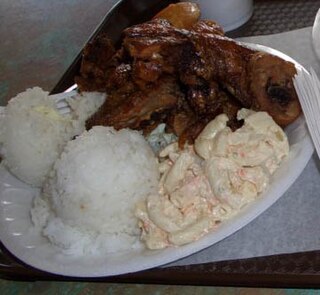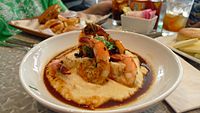
Grits are a type of porridge made from coarsely ground dried maize or hominy, the latter being maize that has been treated with an alkali in a process called nixtamalization, with the pericarp removed. Grits are cooked in warm salted water or milk. They are often served with flavorings as a breakfast dish. Grits can be savory or sweet, with savory seasonings being more common. Grits are similar to other thick maize-based porridges from around the world, such as polenta and mieliepap. The dish originated in the Southern United States but is now available nationwide. Grits are often part of a dinner entrée shrimp and grits, served primarily in the South.

The cuisine of the Southern United States encompasses diverse food traditions of several subregions, including Tidewater, Appalachian, Ozarks, Lowcountry, Cajun, Creole, African American Cuisine and Floribbean cuisine. In recent history, elements of Southern cuisine have spread to other parts of the United States, influencing other types of American cuisine.

Brazilian cuisine is the set of cooking practices and traditions of Brazil, and is characterized by European, Amerindian, African, and Asian influences. It varies greatly by region, reflecting the country's mix of native and immigrant populations, and its continental size as well. This has created a national cuisine marked by the preservation of regional differences.

An omelette is a dish made from eggs, fried with butter or oil in a frying pan. It is a common practice for an omelette to be folded around fillings such as chives, vegetables, mushrooms, meat, cheese, onions or some combination of the above. Whole eggs or egg whites are often beaten with a small amount of milk, cream, or water.

Louisiana Creole cuisine is a style of cooking originating in Louisiana, United States, which blends West African, French, Spanish, and Native American influences, as well as influences from the general cuisine of the Southern United States.

Cornmeal is a meal ground from dried corn (maize). It is a common staple food and is ground to coarse, medium, and fine consistencies, but it is not as fine as wheat flour can be. In Mexico, very finely ground cornmeal is referred to as corn flour. When fine cornmeal is made from maize that has been soaked in an alkaline solution, e.g., limewater, it is called masa harina, which is used for making arepas, tamales, and tortillas. Boiled cornmeal is called polenta in Italy and is also a traditional dish and bread substitute in Romania.

Danish cuisine originated from the peasant population's own local produce and was enhanced by cooking techniques developed in the late 19th century and the wider availability of goods during and after the Industrial Revolution. Open sandwiches, known as smørrebrød, which in their basic form are the usual fare for lunch, can be considered a national speciality when prepared and garnished with a variety of ingredients. Hot meals are typically prepared with meat or fish. Substantial meat and fish dishes includes flæskesteg and kogt torsk with mustard sauce and trimmings. Ground meats became widespread during the industrial revolution and traditional dishes that are still popular include frikadeller, karbonader and medisterpølse. Denmark is known for its Carlsberg and Tuborg beers and for its akvavit and bitters, but amongst the Danes themselves imported wine has gained steadily in popularity since the 1960s.

The plate lunch is a quintessentially Hawaiian meal, roughly analogous to Southern U.S. meat-and-threes. However, the combination of American and pan-Asian influence makes the plate lunch unique to Hawaii.

Hokkien mee, literally "Fujian noodles", is a series of related Southeast Asian dishes that have their origins in the cuisine of China's Fujian (Hokkien) province.

Loco moco is a dish featured in contemporary Hawaii cuisine. The traditional loco moco consists of white rice, topped with a hamburger patty and brown gravy, and finally a sunny-side up fried egg. These ingredients must exist in the dish to be named loco moco. No other egg variations are considered traditional and the stacking of the dish must be in the aforementioned order to be considered traditional. Variations to egg style, meats, and stacking alters the naming of the dish. Can be accompanied with other toppings and side dishes such as grilled onions and mac/potato salad, but they too are not traditional.

Torta is a culinary term that can, depending on the cuisine, refer to cakes, pies, flatbreads, sandwiches, or omelettes.

Yangzhou fried rice, also known by several other spellings and names, is a popular Chinese wok-fried rice dish. There are many varieties but it most properly describes egg fried rice with mixed vegetables and two forms of protein, typically pork and shrimp with scallions.

Lowcountry cuisine is the cooking traditionally associated with the South Carolina Lowcountry and the Georgia coast. While it shares features with Southern cooking, its geography, economics, demographics, and culture pushed its culinary identity in a different direction from regions above the Fall Line.

The camel rider or desert rider is a type of sandwich that is popular in Jacksonville, Florida. The sandwich is usually made with lunch meats, Italian dressing, and pita bread. It is often served with tabbouleh and cherry limeade.

Hominy Grill was a restaurant in Charleston, South Carolina. It was located at 207 Rutledge Avenue, in the heart of historic downtown Charleston. The restaurant has been delighting tourists and locals alike for almost 24 years. Chef Robert Stehling has been honored by the James Beard Foundation Award as the best chef in the Southeastern United States in 2008 and the restaurant has been featured on The Best Thing I Ever Ate, No Reservations with Anthony Bourdain, Amazing Eats (shrimp & grits and the "Big Nasty" and Man v. Food. The restaurant features amped-up Southern classics and Lowcountry cuisine with an elevated twist.

Okoy or ukoy, are Filipino crispy deep-fried fritters made with glutinous rice batter, unshelled small shrimp, and various vegetables, including calabaza, sweet potato, cassava, mung bean sprouts, scallions and julienned carrots, onions, and green papaya. They are traditionally served with vinegar-based dipping sauces. They are eaten on their own or with white rice. They are popular for breakfast, snacks, or appetizers. Okoy are sometimes dyed bright orange with achuete seeds.




















